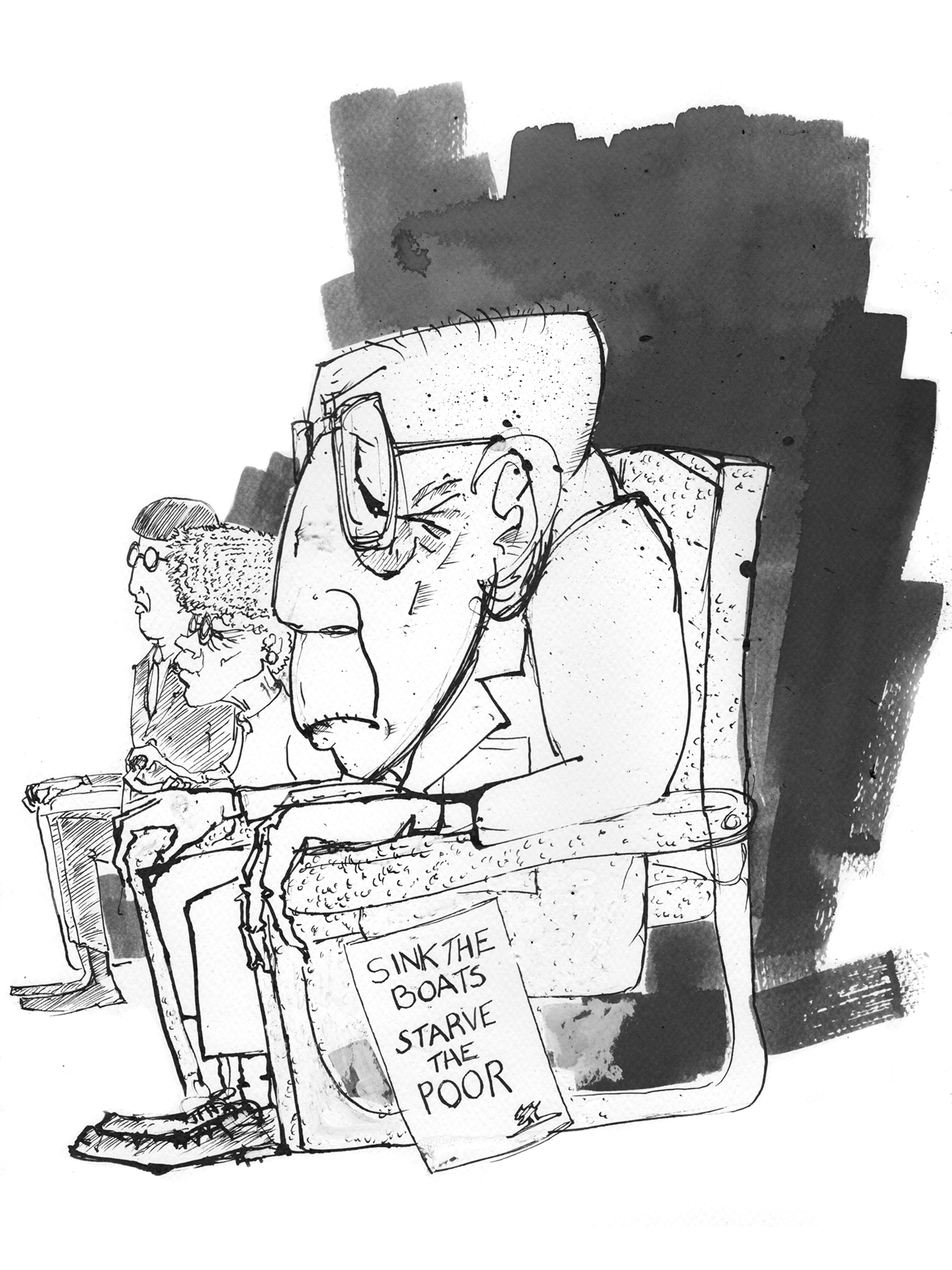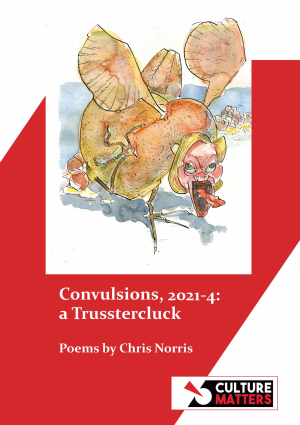

Rebecca Lowe
Rebecca Lowe is a journalist, poet and Quaker peace activist, based in Wales, UK. She is a Bread and Roses Spoken Word 2020 Award winner, has appeared on BBC radio, and her poetry has featured in many anthologies including Red Poets, Blackheath Countercultural Review, and the Ymlaen/Onward! anthology of radical Welsh poetry (Culture Matters, 2019).

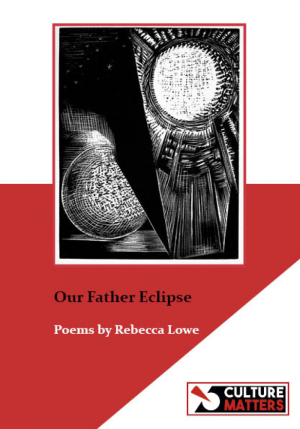
Am I A Political Poet?
'We live in capitalism. Its power seems inescapable. So did the divine right of kings. Any human power can be resisted and changed by human beings. Resistance and change often begin in art, and very often in our art, the art of words.' – Ursula K LeGuin, from her acceptance speech for The National Book Foundation Medal for Distinguished Contribution to American Letters, 2014.
‘Are you a political poet?’ is something I occasionally get asked. My two favourite conversation subjects are politics and poetry (plus religion…perhaps this is why I never get invited to dinner parties!) I am definitely political. And poetical. But am I a political poet?
I never set out to write political poetry. I just write about the things that matter to me, the things that grab me by the heart and twist it, the sorts of things that if I didn’t write them down would bubble around in my head and probably explode. My husband says I am becoming angrier as I get older. He blames it on the Socialism and the Poetry. But it’s not that. It’s just that there’s so much to be angry about right now, I can’t help it. The chaos and mishandling of the Covid pandemic, the massive inequalities in society, a rising acceptance of food banks as the norm, soaring energy bills, job losses, mostly among the working classes, public sector pay freeze and strikes, the aftermath of Brexit and looming spectre of climate change. Trump and Boris. In such a world, how could anyone not be angry?
At times such as this, all forms of art – and poetry in particular – are a way of dealing with and responding to the brokenness of the world. We tell our truths because we have to, because (to quote Martin Luther): ‘here I stand, I can do no other.’
The best political poems convey a kind of truth which is timeless and universal. They go beyond the time in which they were written and reach into ours. They invite us to question universal, fundamental truths: What is our place in the world, and who decided it? Does our society create the realities we strive for, and if not, how can we make things better?
Leon Trotsky writes, in Art and Politics in our Epoch (1938):
‘Generally speaking, art is an expression of man’s need for an harmonious and complete life, that is to say, his need for those major benefits of which a society of classes has deprived him. That is why a protest against reality, either conscious or unconscious, active or passive, optimistic or pessimistic, always forms part of a really creative piece of work. Every new tendency in art has begun with rebellion.’
It is this restlessness – this call to rebellion – which fires us into self-expression. Art, and poetry in particular, is both a response and a challenge to the world we find ourselves living in. It can never be unbiased, because the very act of writing creates our own reality. The very best political poems both challenge the reader and inspire us to new visions.
Whenever I try to define what is meant by political poetry, I keep coming up against this word: Truth. What is meant by truth? Are certain truths universal, or is the very nature of what we understand as ‘truth’ always changing?
Nietzsche, in his 1873 essay Truth and Lying in an Extra-Moral Sense argues that there is no such thing as absolute truth. People create the concepts through which they define what is good or just, and these values are changeable as they adjust to shifting cultural values and belief systems. We create our own ‘truth’ about the world through our use of metaphor, myth, and poetry.
Truth, fact and fiction
We live in what’s often referred to as a ‘Post Truth world’. Post Truth is described in the Cambridge Dictionary as: 'relating to a situation in which people are more likely to accept an argument based on their emotions and beliefs, rather than one based on facts.' A classic example is Tony Blair's justification for the invasion of Iraq despite having found no evidence of weapons of mass destruction: ‘I only know what I believe’.
At a time when politicians routinely lie, change their minds and manipulate data to suit their own agenda, we are rapidly approaching what the writer Hannah Arendt (Lying in Politics, 1972), termed defactualization – a point at which falsehood becomes so commonplace that it is impossible to distinguish fact from fiction:
'Truth or falsehood—it does not matter which anymore, if your life depends on your acting as though you trusted; truth that can be relied on disappears entirely from public life, and with it the chief stabilizing factor in the ever-changing affairs of men.'
Truth is a recurring theme in my poetry collection, Our Father Eclipse (Culture Matters, April 2021) – the question of who we turn to for answers when all the ‘traditional’ pillars of authority – the State, the Church, scientific impartiality – are no longer trusted. At such times, it can be tempting to switch off the rational part of our brain and seek comfort elsewhere, to try to pretend that the ugliness in the world isn’t really happening:
Let’s put on some music,
Let’s dance to the End of Times, a dystopian waltz,
Let’s sing happy songs, think positive thoughts,
Switch off your mind and live in the Now,
Whilst all around us the world burns,
Whilst all around us, the people die.
The forest is on fire—
You write a poem
Praising the beauty
Of a tree. '
- from ‘Beyond Borders’, Our Father Eclipse, by Rebecca Lowe, Culture Matters, 2021
The Russian poet Yevgeny Yinokurov (b.1925) addresses the issue of truths/untruths in his poem Lies:
Telling lies to the young is wrong.
Proving to them that lies are true is wrong.
Telling them that God's in his heaven
And all's well with the world is wrong.
The young know what you mean. The young are people,
Tell them the difficulties can’t be counted,
And let them see not only what will be
But see with clarity these present times…
- (p 476, from The Penguin Book of Socialist Verse edited by Alan Bold 1970, publ. Penguin)
Good poets, like good parents don’t sugarcoat the truth. Readers know what the world is really like. Though it might grant us temporary relief sometimes to sink into a poem like a cosy old armchair, the world is not always comfortable or safe. We need to tell these uncomfortable and often painful truths if we are to remain honest. Effective political poetry not only reflects reality in all its harshness but dares to challenge the many truths we have been conditioned to believe. The Italian poet Giovanni Giudici (b.1928) does this very effectively in his poem ‘You Ask Me What It Means’:
You ask me what the word
alienation means:
from birth you start dying
In order to live through a master
who sells you out; start co signing
what you have – power, love, hatred –
so that you may obtain
sex, wine, heart-break
It means that you are beside yourself
but you think that you are
just your own self, because
the wind undermines you, and you yield...
- p.417, from The Penguin Book of Socialist Verse edited by Alan Bold, Penguin 1970)
Radical passion and revolutionary compassion
There comes a time in everyone’s life (doesn’t there?) when you start to question the version of reality that has been fed to you. Perhaps even more so, in this time of growing political and social unrest, where conspiracy theories arise to fill the gaping gulf between our expected future and the grim and frightening reality. At some point, you start to wonder if the dreams you were sold – of a capitalistic world filled with material luxuries which were yours for the taking if you worked hard and didn't think too much about where they came from or at whose expense – were even worth having. Or where you started to realise that the dreams you were sold were actually nightmares in disguise.
Political poetry, at its best, picks at the seams of the perceived norm, whether it’s war poets challenging the harsh realities of the battlefield against the gung-ho heroic myths they were fed, or women challenging a patriarchally-structured society. Or poets of the Black Lives Matter movement, challenging a world in which people of colour are twice as likely to be stopped and searched, and more likely to be subjected to police brutality.
It’s at times like this when we find our voices – not necessarily because we choose to write political poetry, but because we have to, because we are angry at what we see and heart and pen give us no other option.
In a world where truth is a rare commodity, we need to sing, shout and write. We need to speak up boldly and honestly, with radical passion and revolutionary compassion, challenging social injustice, prejudice and inequality. And yes, if that occasionally makes me a ‘political poet’, then I’ll proudly own that title.
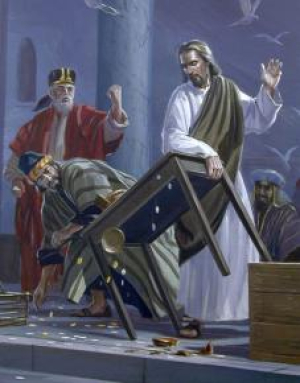
Jesus Comes to the Christmas Parade
Jesus Comes to the Christmas Parade
by Rebecca Lowe
Jesus came to the Christmas parade,
strangely incongruous amongst
all the dancing reindeer and artificial snow,
almost apologetic, shuffling forward
in his cheap polyester robes.
(The beard, at least, was real,
unlike Santa's, which was looking
decidedly threadbare).
A troop of Army fusiliers
marched past, bearing a six-foot
inflatable Santa, anchored
by ropes ('Let's hope they hold
tight and he doesn't float
away over the bay!' guffawed
the commentator over
the loudspeaker).
One of them carried
a ceremonial sword, to bear
the traditional Christmas message
of Peace and Goodwill to all
(so long as they are not Russian,
Middle Eastern or North Korean).
A scuffle broke in the crowd,
As children and adults alike
Sharp-shouldered their way
to the front, for a glimpse
of a princess in a
human-sized snowglobe.
Jesus looked tired,
resigned, perhaps,
an asylum-seeker fleeing
something colder than death -
indifference or blank
incomprehension.
And if the robes looked fake,
the wounds seemed
real enough - he kept
holding his palms to his face,
inspecting the holes, as if he
still couldn't really believe
he was there -
A small boy in the crowd
pointed and said:
'Hey! It's Jesus!'
His mum feigned a smile,
fished a bottle of Cola
from her bag to keep
him quiet.
And me? I just sat
and watched the whole
sorry charade, wondering:
Is this the way
he really comes back?
And is he defeated,
Or is he just
biding his time?
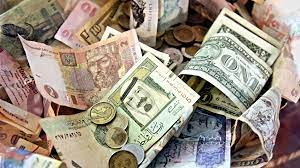
From Benjamin to Hirst: Art in a Disposable Age
Image above: "Currencies" by 16:9clue is licensed under CC BY 2.0.
We live in a disposable age. If any further proof of this was needed, we need only look at the latest publicity stunt by Damien Hirst. No stranger to controversy, the artist who made his name pickling animals in formaldehyde set fire to 1,000 of his artworks, livestreaming the event on Instagram, and is set to burn thousands more. It’s part of his nonfungible token (NFT) project ‘The Currency’. With the collection of 10,000 pieces featuring his famous spot prints, collectors were given a choice: take a physical Hirst original or opt for an NFT digital version. Over half chose the digital one.
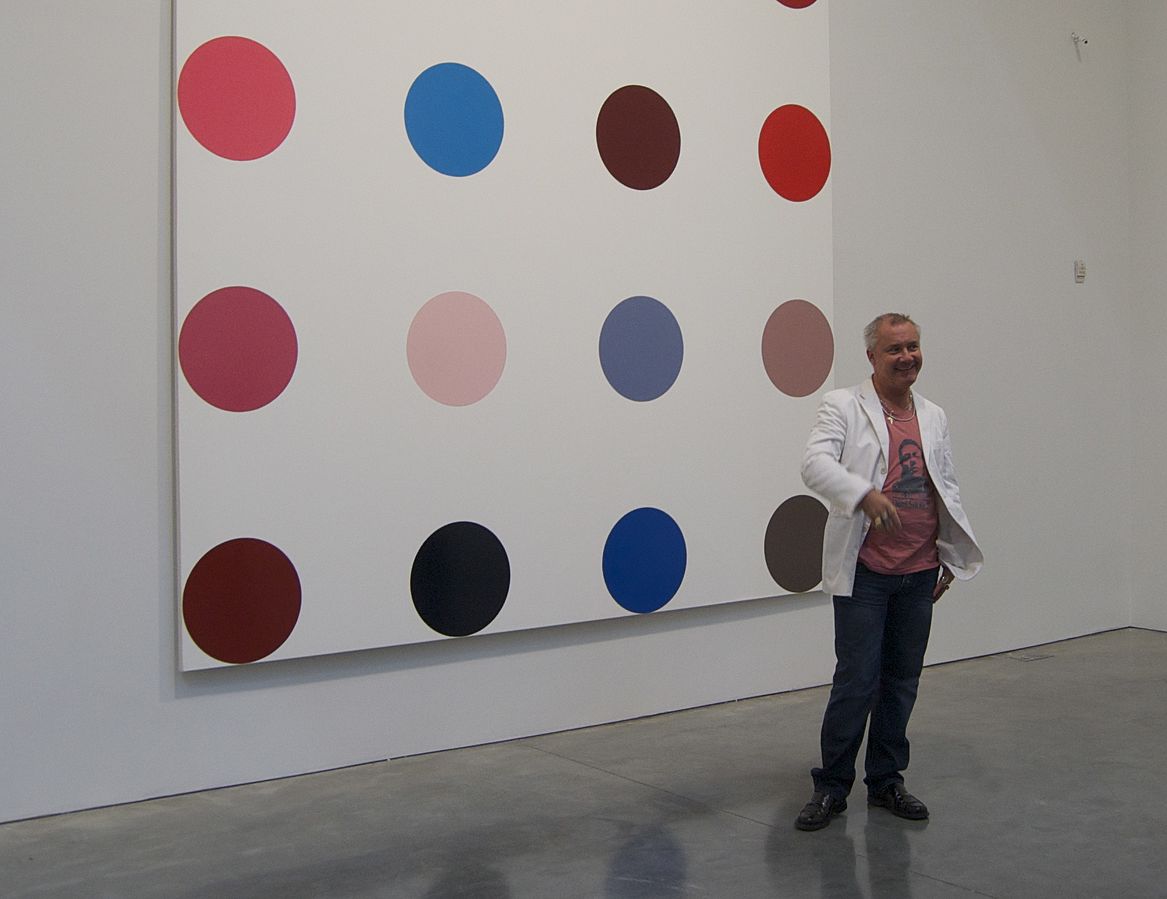
For an old fogey like me, the idea of replacing a ‘real’ physical artwork with a digital piece feels like a poor deal. But then I was born in an age of notepads, pens, physical books and not a Kindle or iPad in sight. Most students today own few CDs, instead downloading everything on Spotify. DVDs are rapidly becoming obsolete in an age of Netflix subscription. Meanwhile, digital printing has transformed the world of publishing, opening the door for new writers to print on demand, rather than jump through the hoops of traditional publishers. Arguably, this can be a good thing, democratising art, making it more accessible and freeing it from the confines of academic gatekeeping. In the world of music, platforms such as Bandcamp allow upcoming bands to instantly record and stream their creations to would-be fans across the globe.
And yet…there is something dystopian about the disposable and temporary nature of digital art. The fact that Hirst’s actions were livestreamed on Instagram is telling. We live in an era where nothing is ever ‘real’ unless it has been streamed online. We reveal our inmost secrets to strangers, playing out the movies of our lives in real-time, watched by millions. We scroll through a daily diet of doom, gloom and fear, as computer algorithms analyse our every move, sending us down ever darker rabbit-holes of conspiracy and half-truths. In so doing, so we rapidly become the witness of our own destruction.
I am reminded of this famous quote from Walter Benjamin’s ground-breaking sociological essay, ‘The Work of Art in the Age of Reproduction’:
Mankind, which in Homer’s time was an object of contemplation for the Olympian gods, now is one for itself. Its self-alienation has reached such a degree that it can experience its own destruction as an aesthetic pleasure of the first order.
Benjamin’s essay was written in 1936, a time when mass-produced media was just starting to take off in a big way. Fine art pieces, valued for their uniqueness, were now able to be copied and disseminated in high volumes to the masses. At the same time, the advent of moving pictures through film was able to capture moments in real time – something the Old Masters could only have dreamed of. And whilst this was good for the democratization of art, bringing it to new audiences, it also opened the gateway for its capitalist commodification.
All artists must face this dilemma – how to share our work with a wider (not small, elitist) audience whilst at the same time maintaining originality and integrity. A painting locked in a vault for its high financial value is no longer art but commodity. Likewise, a manufactured popstar churning out music-by-numbers hits at the behest of a money-grabbing producer might earn millions, but loses a part of their soul in the process.
Marx himself acknowledged something of this dilemma, with his statement:
capitalist production is hostile to certain branches of spiritual production, for example, art and poetry’ - (p.141, Economic Manuscripts, 1857-1858).
This is not to deny the possibility of the development of literature and art under capitalism. However, the very nature of the capitalist system of exploitation is in contradiction with the humanist ideals which inspire genuine artists.
As the world looks on as Hirst’s original artworks go up in smoke, I am left wondering – can digital art, with its potential for infinite reproductions, ever be anything but a poor substitute for the real thing?
Perhaps it is the ephemeral nature of art which lies at the very heart of its appeal. It speaks, ultimately, of our own mortality – the primeval urge to leave something of ourselves behind for future generations to enjoy, even if we know, in our heart, that it cannot last. It is this same desire that fuels the dispossessed and disenfranchised to scrawl their tags across every suburban city wall – the need to not feel disposable, to shout to the world: ‘I Was Here’.
Perhaps – who knows – this is the point that Hirst is trying to make? That, in the midst of a digital, disposable era, the only ‘real’ thing, the only thing worth possessing, is a knowledge of our own unique but temporary imprint upon the world? If so, it is a point well made. We must cling onto such brief moments of sublime beauty as often as we can. We have no idea how quickly they might be gone.
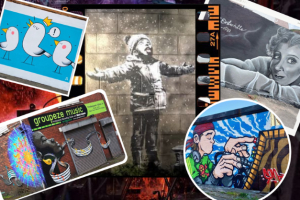
Banksy’s 'Season's Greetings' and a lesson in the commodification of art
In December 2018, Ian Lewis, a steel worker from Port Talbot in South Wales, woke to an early Christmas present – an artwork by world-renowned street artist Banksy had appeared overnight on his garage.
Season’s Greetings, as the painting was officially named, is painted on two sides of a wall. One side shows a child playing in what looks like snow. Turn the corner and the ‘snow’ becomes falling ash and smoke from a skip fire.
Mr Lewis’ garage became an overnight tourist sensation, hitting national headlines, as crowds flocked from all over the country to see it.
What follows is nothing less than a salutary lesson. It quickly became clear that the artwork needed protecting. Amid fears of vandalism, fencing was installed, together a screen in front of the wall. Security guards were stationed at the entrance, together with parking attendants.
Next came the news that John Brandler, an Essex-based art dealer, had bought Season’s Greetings for an unspecified six-figure sum, despite not having seen the painting in real life. In May 2019 the piece was moved from the Taibach garage wall to Ty'r Orsaf, the site of the former police station on Station Road, where it was safely positioned behind panes of reinforced glass.
This month came the disappointing news that, despite the townsfolk’s best efforts to keep the artwork in the town where it was created, it was to be rehoused at a gallery in England. Apparently, Mr Brandler had plans to eventually create a street art museum in the Banksy's new home, Ty’r Orsaf, featuring other world-renowned artists. But in June 2019 he scrapped the idea after the cash-strapped Council refused his demands to pay a yearly fee of £100,000 for the loan of the artwork.
So that’s that, then. An artwork which was gifted to the city – and which arguably only makes sense in the context of its original location – is to leave Wales, possibly forever. Capitalism commodifies everything – skills, time, land (I recently read of The Adam Smith Institute’s plan to sell shares for plots on the Moon) and, yes, Art.
Determining the price of a piece of art is a tricky one. Who decides whether Tracy Emin’s bed is art or just…a bed? Or whether a cow pickled in formaldehyde is worth as much as an Old Master? Such decisions often feel arbitrary, based more on reputation than Skill. Even artists play this game. Salvador Dali famously avoided paying for drinks in bars by drawing on the backs of his cheques, making them priceless works of art and therefore un-cashable.
Artists, of course, deserve to make a living. It’s not unreasonable to charge prices that reflect the time, effort and skill required to create something beautiful and unique. The problems arise when collectors and dealers move in, and art becomes prized more for its perceived monetary value than its intrinsic worth. (Banksy, of course, famously played with this concept with his ‘shredded picture’ stunt at a London auction house).
Who determines what a piece of art is worth? A few years back, I bought an original painting for a fiver in my local charity shop. I bought it because I liked it. I’ve no idea who painted it. If tomorrow I was to discover that it was the work of a famous artist, nothing materially would have changed. The painting would be exactly the same as when I bought it. The only difference would be the market value, but the artistic value – the reason I bought it – stays the same.
Street art, by its nature, has always been ephemeral. Images and tags appear and disappear. Unlike the carefully curated art in galleries, historically Street Art has been egalitarian – anonymous or semi-anonymous, created purely for freedom of expression, with no intention of material gain. In a world where so many are made to feel invisible and worthless, it’s a way of rising up through the cracks, a two-fingered salute at the world – a way of shouting ‘I Exist!’
When does Street art become Established Art? A few years ago, Swansea Council, in their wisdom, decided to paint over a Cofiwch Dryweryn mural which appeared on the marina wall – arguably just as strong an artistic statement as the Banksy. When is an artwork deemed graffiti? When the Council considers its message too political? When it’s not judged to be in keeping with the tourism aesthetic of the area? When it poses a threat financially?
Banksy’s ‘Season’s Greetings’, too, was political. It was a statement about pollution, about the town’s industrial past (and future). A statement about how the ugliness of industry can, when viewed through innocent eyes, appear beautiful. About the legacy of a town which in 2018 was listed as the most polluted area of the UK, yet relies upon industry to feed its children. And it’s a child, significantly, who appears in the mural – a symbol of the town’s future, appearing at Christmas when the symbolism of Nativity, and of lost childhood, is at its most redolent. Above all, I think, it is a symbol of hope.
It’s easy to feel hopeless, as the town’s Banksy is lifted onto a crane to begin its long journey to a gallery miles away in England. It’s easy to feel frustration at an opportunity missed. Yet, amidst it all, there is hope. Banksy’s gift to the town has inspired the Port Talbot ARTWalk – a coming together of artists from across the town and farther afield, both known and unknown, to create a stunning walkway of murals and street art.
The ARTWalk is, of course, free for anyone to enjoy. Amid the gloom of a steel-grey February sky, these colourful, rebellious swirls of colour are a joyous shout to the world: We are here, we are the voices of the town, and we are not going anywhere.
Writing on the group’s Facebook page, Derek Davies of Port Talbot ARTWalk explains:
As a community, we will move forward. The fact that the Season’s Greetings artwork is not with us anymore – is that really so important? The mystique about the artwork will remain with us for all time in our town, regardless of not having a piece of wall. The story of the Port Talbot Banksy is part of who we are, the people and the passion of Port Talbot. It stays in the hearts of the people of Port Talbot and that, that cannot be taken away by money or profit. We are the winners, not art dealers. Money is okay for some, but the legend of the Port Talbot Banksy holds far more riches than money can ever, ever buy…And that my friends…is priceless.
So the commodification of Banksy’s Season’s Greetings has, in fact, achieved just the opposite. Rising up from the streets is unbridled freedom of expression – uncommodified, de-monetised, freed from the shackles of galleries and dealers. This is Art for Art’s sake. I reckon Banksy would be proud.
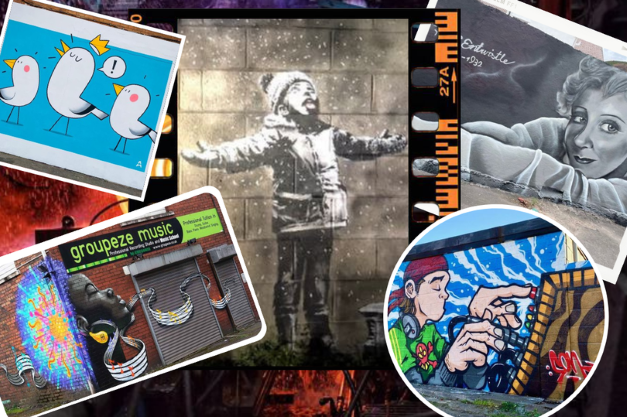
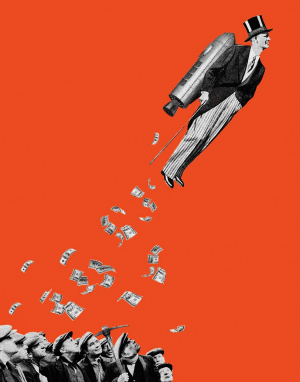
Camels and Needles
Camels and Needles
by Rebecca Lowe
‘It is easier for a camel to pass
Through the eye of a needle
Than for a rich man to enter heaven’…
‘Ah,’ you say,
‘But it depends on the size of the needle,
It depends on the size of the camel.’
Poverty is relative
only for the rich.
Try telling the woman
queuing up outside the foodbank
that poverty is relative –
She has spent half a day
and most of her remaining cash
getting on and off of buses
to reach the benefits office
to be told that due to a ‘technical hitch’
her universal credits payment
has been delayed –
It’s raining,
The baby in the pram yowls,
She yanks down her hood,
hoping nobody will see her and judge.
Everything is relative.
Like, it’s relative
not to care about buying fairtrade food
to help the starving children in Africa,
like the smiling church lady said you should,
when you’ve five children
of your own at home
going hungry.
Like, it’s relative for the woman
behind the benefits counter
on a moderate income
to close down her computer
at the end of the day
and go back to a decent meal
and a warm home.
Like, it’s relative
for the politician who declares
there’s no need to increase the
basic rate of universal credit
because ‘£85.68 a week is plenty’,
then treats his colleagues
to a meal and a £100 bottle of wine.
Everything’s relative –
Camels and needles
The myth of the trickle-down economy,
Money leeching up from poor to rich,
Lining the pockets of greed:
‘But I worked hard to get where I am today’
Tell that to the nurse on basic wage,
who today held the hands of a dying woman
and learned that her work is not worth
more than a one per cent pay rise
Tell that to the single mum working
three jobs to pay the rent on a flat
with mould growing up the walls.
Tell that
To every worker
In every city
In every country
Of the world
When the camel finally manages
To squeeze through that needle,
I might just believe it!
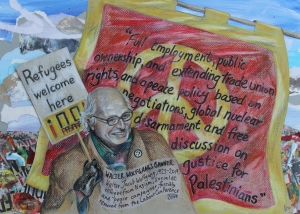
Blooding
Blooding
by Rebecca Lowe
'After the first, it becomes easier,'
The cold, wild-eyed stare of the deer,
A crazy fish-eye lens looking backwards
through terror - you shiver,
You are only twelve years old
and know what's coming,
You've seen it before,
A fistful of blood on your face,
Still warm, from the dead beast,
The violence of your father's pride,
You smile, trying not to retch -
A rite of passage -
At school they taught you how
to stand in line - no flaws,
No questions, no insubordination,
To stand up straight, as the
Inspecting Sergeant hurled
Insult after insult,
To stand up straight,
And never to cry.
'After your first, it becomes easier',
Easier to stand on the side
of the strong, and so you become
the hunter, not the quarry,
Learn to inflict pain
quickly and humanely,
Learn to look away,
And never catch
Another's eye -
A rite of passage -
One day, you will run
A company,
A city, a country -
You will learn to push buttons,
You will learn to issue orders,
You will learn to look away -
A rite of passage -
And learn to ignore
Any sense of horror
or revulsion, or fear,
That after the first,
Tenth, hundredth, thousandth,
It has become easy,
Oh yes, it has become
All too frighteningly easy.
The image above is Walter Wolfgang's Banner, by David Hugh Lockett

